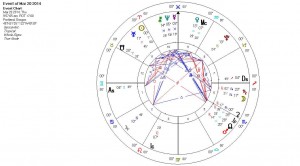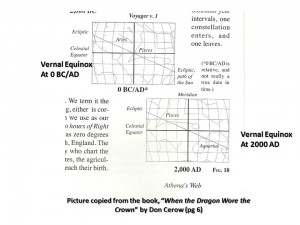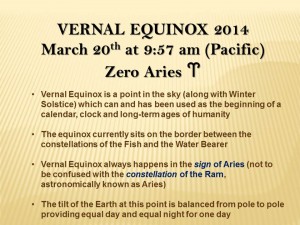Aries and the Astronomical Clock
On Thursday, March 20, 2014 at 9:57 am Pacific time, the Sun moved into the sign of Aries, which starts up the season of spring.  The point that the Sun moves into Aries is called Vernal (or Spring) Equinox in the western world. It is the time of equal-day and equal-night all over the globe. It is the time of rapid growth and just as rapid changing of weather patterns. But it is also marked as a projection into the cosmos where the star patterns known as constellations speak the stories of our ancestors and mythologies, our pantheons of Goddesses and Gods and truly the larger scope of world ages recorded in the sky.
The point that the Sun moves into Aries is called Vernal (or Spring) Equinox in the western world. It is the time of equal-day and equal-night all over the globe. It is the time of rapid growth and just as rapid changing of weather patterns. But it is also marked as a projection into the cosmos where the star patterns known as constellations speak the stories of our ancestors and mythologies, our pantheons of Goddesses and Gods and truly the larger scope of world ages recorded in the sky.
Today in the modern western world there is little appreciation of the significance of this time beyond the warmer weather that tends to build in March and April in the northern hemisphere. Looking into the stars is an afterthought, except to astronomers, cosmologists, archeo-astronomers and some astrologers.
Nowadays, we have observatories and satellites that do all the tracking while the vast majority of us go about our business. Most of the world’s population now lives in urban environments where the city lights and/or air pollution block out much of the starlight, creating a focus away from the seasons and constellations.
If we could see the stars, we would notice, without the use of telescopes that spring in the northern hemisphere begins on the outer  edge of the Fish constellation (astronomically known as Pisces), still a great number of years off from prescessing (moving backwards) into the constellation of the Water Bearer (known in astronomy as Aquarius). I must note, however, that the boundaries of the constellations were re-drawn in the early 20th century, almost arbitrarily by the International Astronomers Union (IAU). But it is clear by connecting the pinpricks of light that even without the re-drawn boundaries the Vernal Equinox remains in The Fish constellation. Why is this important?
edge of the Fish constellation (astronomically known as Pisces), still a great number of years off from prescessing (moving backwards) into the constellation of the Water Bearer (known in astronomy as Aquarius). I must note, however, that the boundaries of the constellations were re-drawn in the early 20th century, almost arbitrarily by the International Astronomers Union (IAU). But it is clear by connecting the pinpricks of light that even without the re-drawn boundaries the Vernal Equinox remains in The Fish constellation. Why is this important?
Vernal Equinox is a way to tell time through not only yearly solar calendars, but also provides a marker for the much longer great ages of Earth’s history. These great ages are measured by the slow wobble of the Earth and the Sun’s passage through the twelve zodiacal constellations. After roughly 25,800 or 25,900 years, the Sun goes through each constellation at Vernal Equinox. That makes approximately 2,150 or 2,160 years per constellation. Knowing that, one can arrive around the time when Vernal Equinox moved from the constellation of the Ram (aka astronomical Aries) into the constellation of the Fish a little over two thousand years ago.
There are differing opinions as to the start of this current age and the start of the next one. Don Cerow of “When the Dragon Wore the Crown” gives an approximate date of 0 AD (for reference only and not a true date) when the Vernal Equinox reached the constellation of the Fish. Daniel Giamario of the Shamanic Astrology Handbook uses a rough date of 100 BC as the age of the Fish. In the book, “Hamlet’s Mill” by Giorgio de Santillana and Hertha von Dechend, the are several references to the Age of Pisces (or the Fish) and 6 BC comes up twice, depending on what a person uses to measure the start of the new age. The age of the Fish heralded the age of Christianity and the dominance of monotheistic religion, among other major events.
So where does one start the age? Astronomers, astrologers, historians and other researchers would give a variety of answers especially for the start of the age we are still in (Fish) the one we are about to cross into (Water Bearer). There is another measurement that involves the alignment between the ecliptic, the winter solstice, the galactic center and the galactic plane (this is exactly what is happening now and has not happened in thousands of years), but that is really beyond the scope of this article. What is important here is that we are surely in the hallway extending into the next age and Vernal Equinox is looms large in that measurement. However, it isn’t the only point with which to measure the seasons, years and great ages as I mentioned above. In addition, Winter Solstice is also an equally demonstrable yearly point with which to use and has additional fuel because it is the time of the Sun’s rebirth into light.
 Vernal Equinox also signals the arrival of the Aries solar energy or fuel. This is a time of action, decisiveness, rapid growth, focused attention, compulsion to move, testing of individuality, acceleration and execution of a mission or a worthy cause. Aries represents the warrior-archetype. Looking around at how life responds to the arrival of spring, it is easy to see the excitement and vibe in the air and why the sign of Aries best fits into the first 30 days of spring.
Vernal Equinox also signals the arrival of the Aries solar energy or fuel. This is a time of action, decisiveness, rapid growth, focused attention, compulsion to move, testing of individuality, acceleration and execution of a mission or a worthy cause. Aries represents the warrior-archetype. Looking around at how life responds to the arrival of spring, it is easy to see the excitement and vibe in the air and why the sign of Aries best fits into the first 30 days of spring.
In ancient times, most “warriors” were not full-time and called up only in times of urgent need. The rest of the time they tended to live outside the urban centers and were farmers and had other agrarian jobs. It is only in roughly the last 3000-4000 years where the warrior was birthed in a new image of the patriarchy: one mostly of fighting armed battles and wars.
In this new age in which we are moving as a planet, it is a time to look at how the warrior is expressed and the distortion it is has become in many current cultures. The Gods and Goddesses that best represent Aries starts with Mars, but the origins go back to ancient Greek, Etruscan, Assyrian, Babylonian and before. The Greek god, Ares was the original war god as full dedicated to weapons, battle and war. However, several gods and goddesses had aspects to them that represented war or battle and usually come from more ‘earthy’ origins like Artemis, Athena, Enyalius and Agrotora. The astrological sign of the warrior Aries is evolving again in this coming new age.
One can gain clues as to the new Aries archetype in the background star patterns that the sign of Aries currently occupies: primarily in the Water Bearer constellation with a little overlap in the Fish. According to Bernadette Brady in her book, “Brady’s Book of Fixed Stars”, the Water Bearer constellation has been linked with a man holding an urn or other vessel containing water that is being poured onto the horizon. In cultures throughout the Mediterranean and the Middle East and even in India thousands of years ago it was associated with waters pouring out in a rush. Back around 4000 BCE, this constellation marked Winter Solstice. But what do the waters contain? Are they life-giving, as the ancient Egyptians saw it, or the cause of the cause of the great deluge as the Babylonians referenced it?
According to William Tyler Olcott in his book, “Star Lore”, while also referring to the great deluge, his research uncovered the Water Bearer constellation was the 11th constellation and the 11th month called, “shabatu” or “curse of rain”. But it is also referenced in Star Lore is the relation of this constellation to have “characteristics of poets, scientists, and observers of the heavens” (pg 33).
This new age could very well be the coming of more water or another great deluge in the future. But I’m inclined to believe more about the waters being life-giving and since water is associated with the feeling-function within us, it can provide the sign Aries with sensitivity and compassion for its brothers and sisters. It is also a novelty to pour water into the parched deserts of Egypt and Babylonia and so this could also mark more thought in the actions of Aries.
As the spinning world rights its bearings to Vernal Equinox, humanity is being asked about our ancient ties to stars and how we can apply it here in our lives. Vernal Equinox should be a cause for celebration of the Sun’s light beginning to overcome the six months where night dominated the lands and oceans. How can we live more fully in the moment rather than equinox being just another day? With the planet Uranus nearby the equinox point with relation to the planets occupying near the solstices and opposite equinox, we can see this rare formation and how important this time is in which we live. Let’s acknowledge it and honor it and more than that have an awareness of where we are in the larger timeline, the great ages of humanity beginning with Vernal Equinox.
By Erik M Roth, Shamanic Astrologer 3/19/2014
References:
- Hamlet’s Mill by Giorgio de Santillana and Hertha von Dechend
- Shamanic Astrology Handbook by Daniel Giamario with Cayelin Castell
- Star Lore by William Tyler Olcott
- When the Dragon Wore the Crown by Don Cerow
- Brady’s Book of Fixed Stars by Bernadette Brady
- Solar Fire Gold v8 astrology software by Esoteric Technologies
- Wikipedia.org with material from sections on Mars, Ares and Enyalius
Excellent article on this year’s Spring Equinox. I am also inclined to believe this is the time of life-giving waters replenishing the spirit and honoring the waters within each soul to truly embody the inter-connectedness of all of our relations.
So if i look at the opposite side of the sky from where I saw Saturn, I can imagine or see Uranus near the equinox point — and tune in?